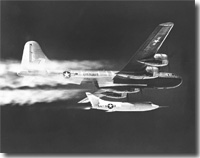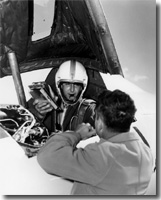50th ANNIVERSARY OF FIRST MACH 2 FLIGHT RECALLED
November 19, 2003
Release: 03-57

Fifty years ago this month, A. Scott Crossfield became the fastest man alive. On Nov. 20, 1953, shortly before the 50th anniversary of powered flight, Crossfield piloted the Douglas D-558-II Skyrocket research aircraft to Mach 2 – twice the speed of sound, or more than 1,290 mph.
Crossfield’s milestone in aeronautical history came at a time when the U.S. Air Force and the U.S. Navy were pushing the frontiers of flight, flying a stable of exotic experimental research airplanes from Edwards Air Force Base in Southern California’s high desert. Higher, faster, farther was the mantra as speed and altitude records were being set – and broken – by a cadre of Air Force, Navy and the National Advisory Committee for Aeronautics (NACA) test pilots. As an aeronautical research pilot at the NACA High-Speed Flight Research Station (HSFRS) – now NASA’s Dryden Flight Research Center – Crossfield was in the right place at the right time, flying such early X-planes as the X-1, X-4, X-5, XF-92A and the D-558 I and II.
Although the NACA was primarily interested in obtaining data from its flight experiments in the newly-opened regime of transonic and supersonic flight to aid designers of future aircraft, the Air Force and Navy had a different agenda, maintaining a friendly inter-service rivalry over which service would reach the next major milestone of flight. The Air Force had a major coup with the first supersonic flight by Capt. Charles E. “Chuck” Yeager in the Bell X-1 rocket plane just six years earlier; that service as well as the Navy and Marine Corps had an intense interest in being the first to reach Mach 2.
“The 50th anniversary (of the Wright Brothers first powered flight) was coming up,” Crossfield remembered. “The Air Force was…going to celebrate the 50th anniversary with another Mach number. It just occurred to us that it would be kind of interesting if the Air Force got nudged over a little bit. We were turned down by headquarters because we didn’t do that kind of thing at NACA. …I got a Navy representative on the base to speak to the Navy, and I also got (Marine Corps test pilot) Marion Carl to speak for me in Washington. The next thing we knew, (NACA Director Hugh L.) Dryden had sent (HSFRS chief Walter C.) Williams an authorization to try for one Mach 2 flight.”

“We thought it would be kind of cute if we beat Yeager and the Air Force to Mach 2 in the Navy airplane,” Crossfield recalled. “It was a very friendly competition. This base was made up from the top on down at that time, of fighter pilots, and they’re competitive.”
Although the Skyrocket was designed for a top speed of about Mach 1.5, the addition of extensions on the four nozzles of its rocket engine enabled Crossfield to reach Mach 1.96 in shallow dives in previous flights. “It was very close, but it was all the airplane had in it,” Crossfield reflected.
“Herman Ankenbruck, one of the engineers that was on the airplane, worked out analytically that we could go about (Mach) 2.01, (with) everything working perfectly and getting the advantage of cold weather. Everybody on the base knew that we were going to make the try, but very few people thought that we were going to make it – and frankly we had our own doubts that we just were asking the airplane to do more than it was ever designed to do,” he added.
The NACA flight test team chilled the liquid alcohol fuel to allow more of it to be poured into the Skyrocket’s fuel tanks, and laboriously waxed the rocket plane’s skin to reduce aerodynamic drag. Early in the morning of Nov. 20, 1953, the swept-wing research aircraft was carried aloft by a Boeing P2BS1 (the Navy designation of the B-29 Superfortress) “mother ship,” which climbed for more than 1 1/2 hours before reaching the launch altitude of 32,000 feet. After dropping clear of the converted bomber, Crossfield ignited the Skyrocket’s four-chamber rocket engine and pointed the plane’s nose skyward, reaching 72,000 feet before pushing over into a shallow dive. The Mach meter gradually crept upward as the fuel burned off, and the needle finally stopped at 2.005 – just a hair over twice the speed of sound before fuel was exhausted.
“Fortunately, I lucked out that day and managed to fly what Ankenbruck (predicted), and came out right on the money, within half a percent,” Crossfield added. Crossfield’s record flight was part of a carefully planned program of flight research with the Skyrocket that featured incremental increases in speed while NACA instrumentation recorded the flight data at each increment. The three Skyrockets built by Douglas Aircraft Co. flew 313 research flights, split roughly evenly between contractor and NACA flights, from 1948 through 1956. Skyrocket No. 144, the craft that Crossfield flew to Mach 2, is currently enshrined in the National Air and Space Museum in Washington, D.C.
“The D-558-II, The Skyrocket…got very little notoriety, and yet it was the one airplane of all the research airplane series that really delivered for the design of the whole next several generations of airplanes,” Crossfield recalled. “The Skyrocket was really the airplane that was paying its way with data.”
Crossfield’s Mach 2 speed record was short-lived. Less than a month later, on Dec. 12, 1953, Yeager flew an improved model of the X-1, the X-1A, to a speed of Mach 2.44, or about 1,612 mph.
“Yeager always claimed that he was first to exceed Mach 2,” Crossfield said with a chuckle. “I’d (protest), and he would say to me, ‘Well, you were the first to get there, but I exceeded it’.”
After flying for NACA for five years, Crossfield went on to a distinguished career as a test pilot, engineer and design consultant for North American Aviation participating in the design and development of numerous revolutionary aircraft such as the X-15 rocket plane, and serving in technical, administrative, and government roles in the aerospace industry.
Fifty years later, Crossfield is still involved in experimental aviation as the Centennial of Flight approaches. As Director of Flight Operations for the Wright Experience, Crossfield is training the pilots who will fly an exact replica of the original Wright Flyer during a ceremonial re-enactment of the first powered flight at Kill Devil Hills near Kittyhawk, N.C., on Dec. 17, 2003.
(Crossfield will discuss his milestone first Mach 2 flight of 50 years ago and his current activities with the planned recreation of the first powered flight by the Wright brothers 100 years ago at the National Air and Space Museum in Washington, DC the evening of Nov. 20. Further information about the free lecture, sponsored by General Electric, can be obtained by calling the museum at (202) 633-2398 or via e-mail at lectures@nasm.si.edu.)
A variety of photos of the Douglas D-558-II Skyrocket and Scott Crossfield, including several taken on the day of the first Mach 2 flight, are available for downloading at /centers/dfrc/Gallery/Photo/D-558-2/HTML/index.html Video footage, including historic flight footage of the Douglas Skyrocket and portions of a recent interview with Crossfield, are available by contacting the NASA Dryden public affairs office at (661) 276-3449.
-nasa-
Note to Editors:




























